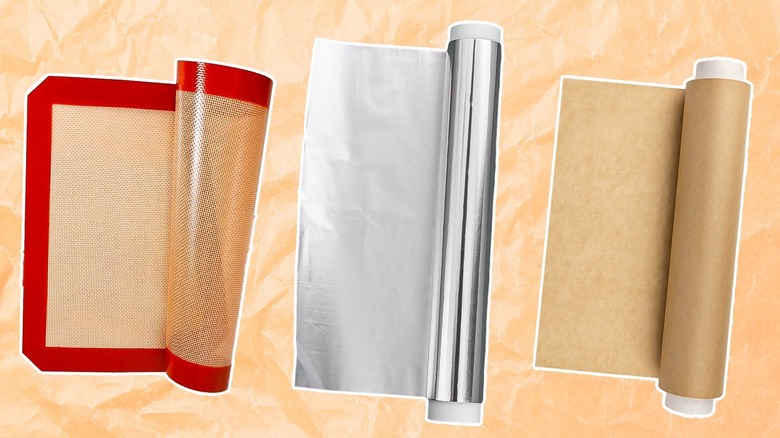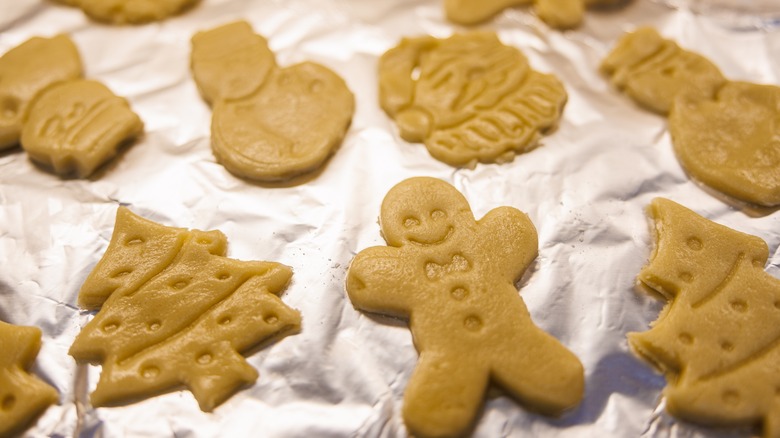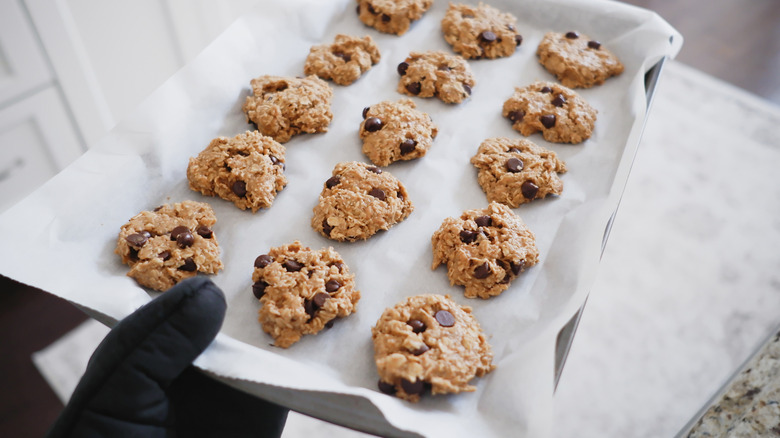Parchment Paper Vs Aluminum Foil Vs Silicone Mats: Which Is Best To Bake Cookies On?
It's often said that baking, unlike cooking, is an exact science. To create the precise chemical reactions that produce perfect cookies every time, you need to not only carefully measure and mix your ingredients, but also select the correct essential baking tools to aid the process. One question bakers often have is which baking surface will result in the tastiest cookies, and we're here to explain why parchment paper is your best bet.
Bakers use a variety of removable surfaces to prevent cookies from sticking to the bottom of their baking sheets, with the most common being aluminum foil, silicone mats, and parchment paper. The most important aspect to consider in making your selection is each material's reaction to heat, because it could have a major impact on the texture and quality of your cookies. Just like the color of your baking sheet matters due to variance in heat conduction, the same principle applies to your nonstick surfaces. Aluminum foil is not recommended for baking because it gets too hot, and while silicone mats work well, they have a tendency to over-insulate. As a result, parchment paper is most recommended by in-the-know bakers like Alton Brown, who tweeted his enthusiastic preference in 2017.
Aluminum foil and silicone mats both have heat-related drawbacks
If you've been lining your baking sheets with aluminum foil, it's best to curb this practice immediately, unless you like your cookies extra-crispy (dare we say burnt?) on the bottom. That's because, like its name implies, aluminum foil is made almost entirely from thin sheets of aluminum metal, which is a powerful heat conductor. In the oven, aluminum foil absorbs so much heat that the bottoms of the cookies, which directly touch the foil, will get hotter and bake faster than the tops. Your resulting cookies won't cook evenly and are likely to burn on the bottom. While aluminum foil is disposable, unlike your baking sheet, it still sometimes sticks to baked goods, making it a less-than-ideal nonstick barrier.
On the other hand, silicone baking mats are non-conductive, and generally a decent option for bakers who want to reduce waste and eliminate single-use kitchen tools. Silicone mats are thicker than parchment paper and aluminum foil, and pre-cut from food grade silicone to fit standard baking trays. The upside is that they are reusable, great at preventing sticking, and fairly easy to clean. The major downside is that, due to their thickness and nonstick properties, silicone mats tend to insulate cookies too much from the heat of the tray and cause them to spread, leading them to get too dense or greasy. Essentially, silicone mats have the opposite problem of aluminum foil— they insulate from heat rather than conducting it!
Overall, parchment paper bakes the best
If you want to ensure your cookies have the optimal texture, parchment paper is the way to go. Parchment paper has been treated with silicone but is much thinner than baking mats, giving it heat-resistant and nonstick qualities while still allowing cookies to come into contact with enough direct heat. Plus, it's better than silicone mats at absorbing grease and moisture. Parchment paper is available in pre-cut sheets or as a roll, making it easy to customize to line all of your pans. It also has many helpful hacks and uses in the kitchen outside of baking cookies! Unfortunately, unlike silicone mats, parchment paper is limited in its reusability, making it a less sustainable option.
Though parchment paper is the overall best pick for baking cookies, there are some instances where another option might be preferable. Super sticky treats like a caramel-based brittle or sourdough cinnamon rolls do well on silicone mats because of the ultra-nonstick quality and durability of the material. And if you prefer an extra-crispy bottom on your cookies, feel free to reach for the aluminum foil. When it comes to baking a batch of classic chocolate chip goodies, however, parchment paper is our pick.


